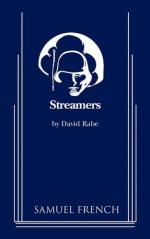|
This section contains 450 words (approx. 2 pages at 400 words per page) |

|
Streamers Summary & Study Guide Description
Streamers Summary & Study Guide includes comprehensive information and analysis to help you understand the book. This study guide contains the following sections:
This detailed literature summary also contains Bibliography and a Free Quiz on Streamers by David Rabe.
Although David Rabe has repeatedly denied that Streamers was conceived of as such, many commentators view the work as the last piece in a Vietnam War trilogy that also includes The Basic Training of Pavlo Hummel (1970) and Sticks and Bones (1972). Like most of the playwright's works, Streamers had a rather involved composition history from its initial conception to its final form. It started out as a one-act play under the working title "Frankie" and was actually begun before Rabe started working on either Basic Training or Sticks and Bones, but it was not completed and staged until both those works had been produced. According to the dramatist, the one-act "contained, in an abbreviated form, the first act of Streamers."
Rabe knew the one-act was not ready for production and in 1969 refused an offer for an Off-Broadway staging. Instead, when he went to work as a journalist in New Haven, Connecticut, he developed the play into a full-length work, first by adding the stabbing of Billy and then by expanding the roles of Sergeants Cokes and Rooney. It was finally ready for production at the end of 1975.
The full-length version of the play was premiered at the Long Warf Theater in New Haven, where it opened on January 30, 1976. Under the direction of Mike Nichols, the main players included Michael-Raymond O'Keefe as Martin, Peter Evans as Richie, Joe Fields as Carlyle, John Heard as Billy, Herbert Jefferson, Jr. as Roger, Dolph Sweet as Cokes, and Kenneth McMillan as Rooney. Nichols also directed the play's restaging in New York at the Mitzi Newhouse Theater, Lincoln Center, where it was produced by Joseph Papp and opened on April 21, 1976. Some of the original cast reprised their roles, but changes included Michael Kell as Martin, Dorian Harewood as Carlyle, Paul Rudd as Billy, and Terry Alexander as Roger. In New York, it ran for over 400 performances and was enthusiastically received by many important critics, including Rex Reed, Christopher Sharp, Edwin Wilson, and Martin Gottfried. A few demurred, including John Beaufort, who, in a review for the Christian Science Monitor, argued that the work was too sensational and was devoid of new insights.
Despite its crude content, for many Streamers remains Rabe' s best work. Its violence and vulgarity may continue to offend some, but the play is certainly the most accomplished part of the so-called trilogy, upon which Rabe's high reputation to some measure still rests. The genius of Streamers was clearly recognized when the play was first staged. Among other awards, it was named the Best American Play for 1976 by the New York Drama Critics and received a Drama Desk Award. It is still the most often staged play in Rabe's dramatic canon.
Read more from the Study Guide
|
This section contains 450 words (approx. 2 pages at 400 words per page) |

|



